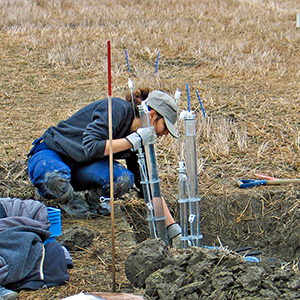Contact
Mona Mossadeghi Björklund
Department of Soil and Environment, SLU
mona.mossadeghi@slu.se

Soil compaction is a serious threat to soil quality, resulting in reduced productivity and adverse impacts on many other soil functions. In a new licentiate thesis, the impact of compaction on water flow in soil was investigated. Moderate compaction resulted in strong preferential flow through macropores, which increases the risk of rapid transport of pesticides and nutrients to the ground water.
Driving agricultural machinery over soils can cause soil compaction, something that has negative consequences for plant root growth and other soil functions.
Mona Mossadeghi Björklund has, in a new licentiate thesis, investigated how soil compaction modifies the soil pore system and soil hydraulic properties, and how this in turn affects water flow in soil. Compaction experiments were performed on two arable fields on clay soil in central Sweden.
–To visualise and quantify soil pore structures and how they were affected by compaction, I used X-ray computed tomography imaging on soil columns taken from the field, and performed tracer breakthrough experiments in the lab, says Mona.
To trace the water flow in soil under natural conditions, additional measurements were done in situ using a dye that allows visualizing water flow patterns at the soil profile scale out in the field. Both laboratory and in-situ measurements indicated that compaction results in more preferential flow. Preferential flow was strongest in moderately compacted soil characterized by dense soil with a few continuous macropores.
Mona’s results showed that even quite small differences in initial soil and site conditions may significantly influence the extent to which applied compaction stresses affect the connectivity of structural pore space in soil and, consequently, water flow.
– Preferential flow through macropores enhances the risk of contaminant and nutrient leaching because the rapid flow and transport in macropores bypasses the soil matrix. Subsoil compaction can also lead to flood generation and runoff, with negative consequences for both farmers and society. To prevent subsoil compaction, it is important to consider soil conditions at the time of trafficking, concludes Mona.
Mona Mossadeghi Björklund will defend her licentiate thesis on the 7th of October 1 pm, at SLU in Ultuna.
Mona Mossadeghi Björklund
Department of Soil and Environment, SLU
mona.mossadeghi@slu.se
Read the licentiate thesis “Soil compaction – effects on soil hydraulic properties and preferential water flow”